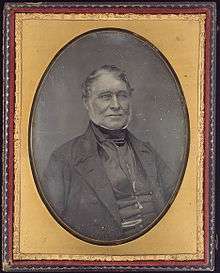Archibald McDonald
| Archibald McDonald | |
|---|---|
 | |
| Native name | Gillespie Moach Aonish Ic lain Ic Alan Dhu |
| Born |
3 February 1790 Leechkentium, Argyll, Scotland |
| Died |
15 January 1853 (aged 62) St. Andrew's East, Canada East |
| Resting place | Saint-André-d'Argenteuil, Quebec, Canada |
| Nationality | British |
| Occupation | Deputy governor of Red River Colony; clerk and later chief trader for the Hudson's Bay Company |
| Years active | 1813–1848 |
| Spouse(s) |
Princess Sunday (m. 1823; d. 1824); Jane Klyne (m. 1825) |
| Children |
Ranald Angus Archibald Junior Alexander Allen Mary Ann John (1836) John (1837–1861) Donald and James Samuel Joseph Benjamin Angus Michel |
| Parent(s) |
Angus McDonald Mary Rankin |
Archibald McDonald (3 February 1790 – 15 January 1853) was Chief Trader for the Hudson's Bay Company at Fort Langley, Fort Nisqually and Fort Colvile and one-time deputy governor of the Red River Colony.
Early life
McDonald was born in Leechkentium (Scottish Gaelic: Leacantuim), Glen Coe, on the south shore of Loch Leven, in Appin, then located in the county of Argyll, Scotland, the last of 13 children born to parents Angus and Mary (née Rankin). His paternal grandfather, Iain (or John) McDonald, had been one of the few male survivors of the Massacre of Glencoe.
The Red River Colony
As a young man, McDonald became friends with Lord Selkirk, and joined the Red River Colony as a clerk and agent, in part because he could act as an interpreter between the overseers of the colony, who spoke English, and the settlers, who, like him, were native Gaelic-speakers. He assisted in recruitment of the second group of colonists in Scotland, with the intention of departing for the New World with them in 1812. McDonald was delayed, however, under Lord Selkirk's orders, to receive further training in medicine and related subjects. In June 1813, McDonald left Scotland with a group of emigrants, arriving on the Red River one year later. In the winter of 1814–15, he was made deputy governor under Miles Macdonell. In 1820, he joined the HBC, and after the merger with the North West Company in 1821, was sent out to the Columbia River.
Hudson's Bay Company
In 1828, he and Governor George Simpson travelled together from York Factory to the Columbia. In the same year, he was promoted to chief trader and put in charge of Fort Langley, near the modern city of Vancouver. He held that post until 1833, when he was reassigned to Fort Nisqually. In 1835, he was assigned to Fort Colville, where he was chief trader from 1833 to 1841, and chief factor until 1844.
In 1848, he retired to St. Andrew's East, Canada East, on a homestead he named "Glencoe House" after his birthplace. It was here that he died in 1853.
Personal life
In 1823, Archibald married Princess Raven (also known as Princess Sunday), daughter of Chief Comcomly of the Chinook Confederacy, but she died in 1824 giving birth to their son, Ranald. In 1825, Archibald married Jane Klyne, a daughter of Michel Klyne, French Canadian postmaster at Jasper House, and Suzanne Lafrance, of a prominent Métis family. They had thirteen children, and remained together until Archibald's death.
| Preceded by James McMillan |
Chief Trader at Fort Langley 1828–1833 |
Succeeded by James Murray Yale |
| Preceded by Francis Heron |
Chief Trader at Fort Colvile 1842–1844 |
Succeeded by N/A |
| Preceded by N/A |
Chief Factor at Fort Colvile 1844–1846 |
Succeeded by Francis Ermatinger |
References
- ↑ Watson, Bruce McIntyre. Lives Lived West of the Divide: A Biographical Dictionary of Fur Traders Working West of the Rockies, 1793-1858. Kelowna, B.C.: Centre for Social, Spatial and Economic Justice of the University of British Columbia. 2010, p. 1061. ISBN 978-0-9810212-7-0.
- Biography at the Dictionary of Canadian Biography Online
- Archibald McDonald
- Manitoba Government Archives
- The Washington Historical Quarterly, Vol. 9 No. 2: Archibald McDonald: Biography and Genealogy, by William S. Lewis